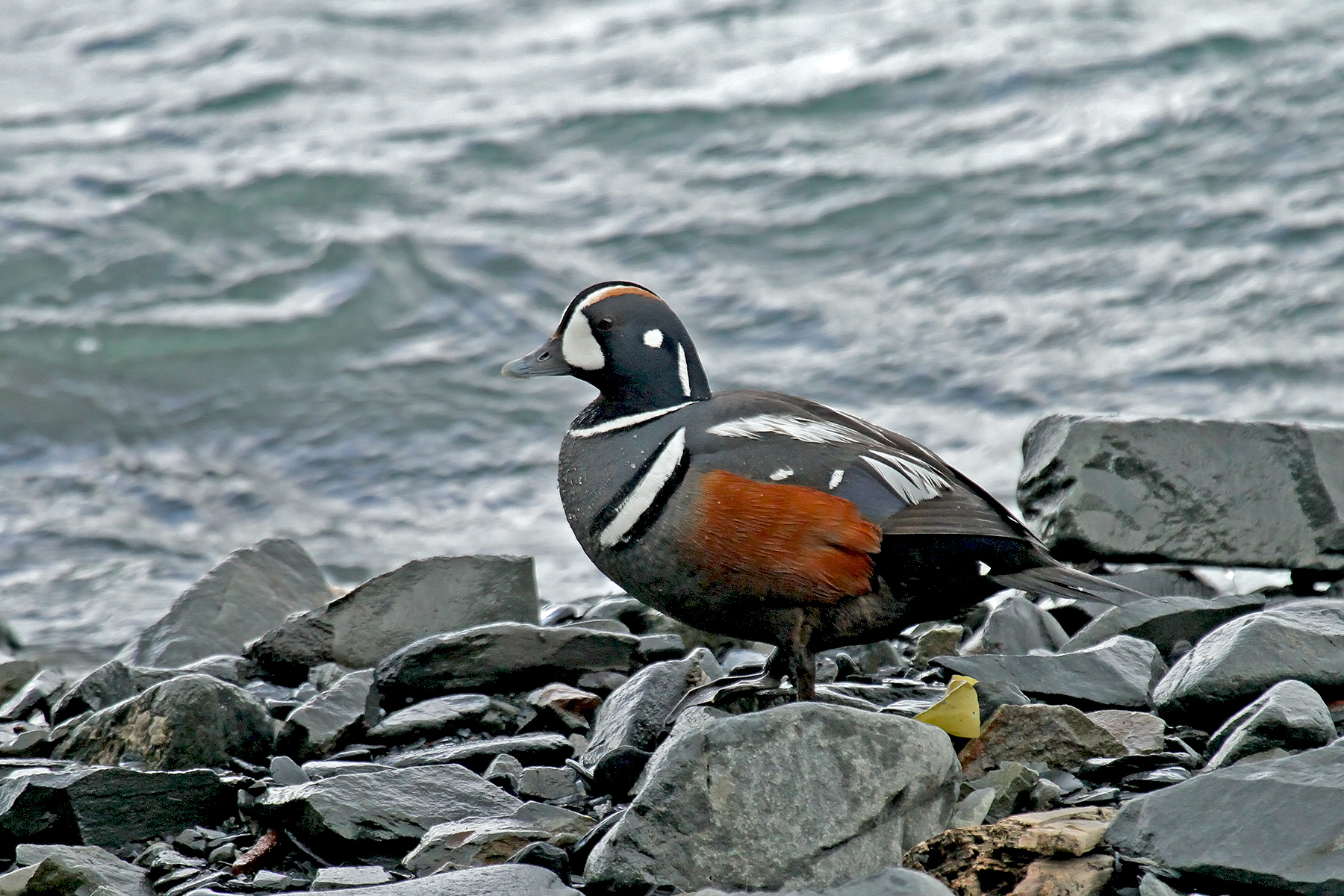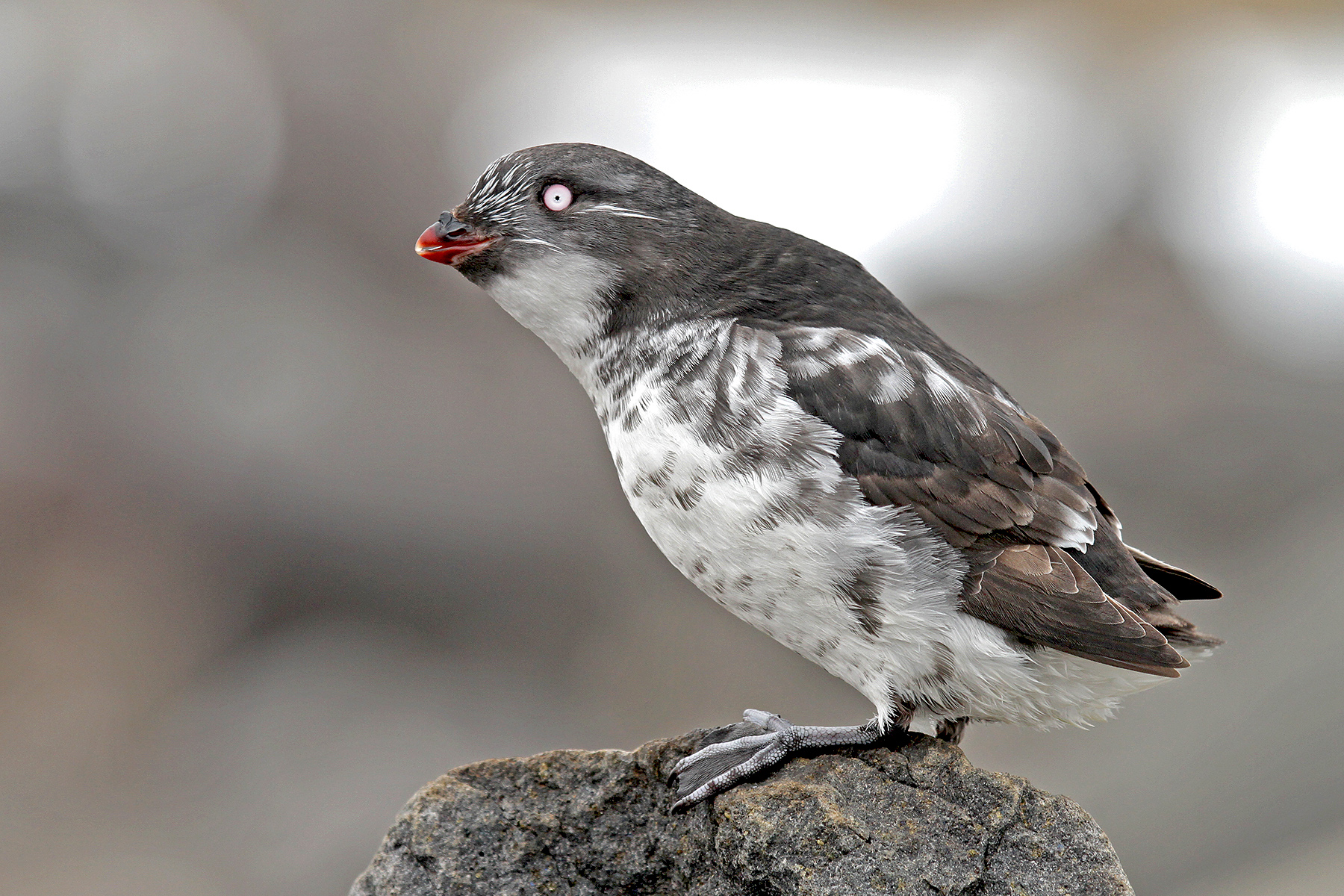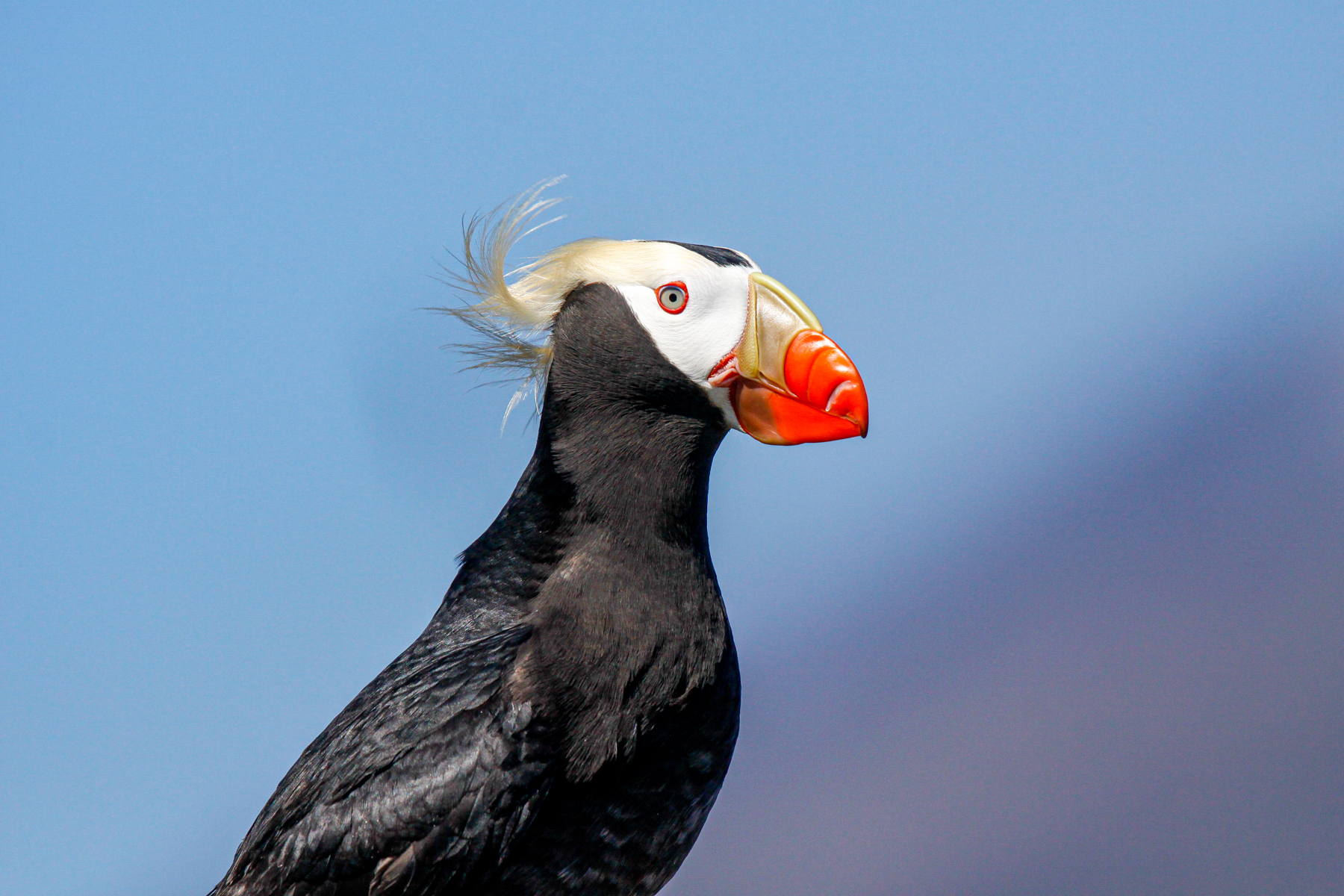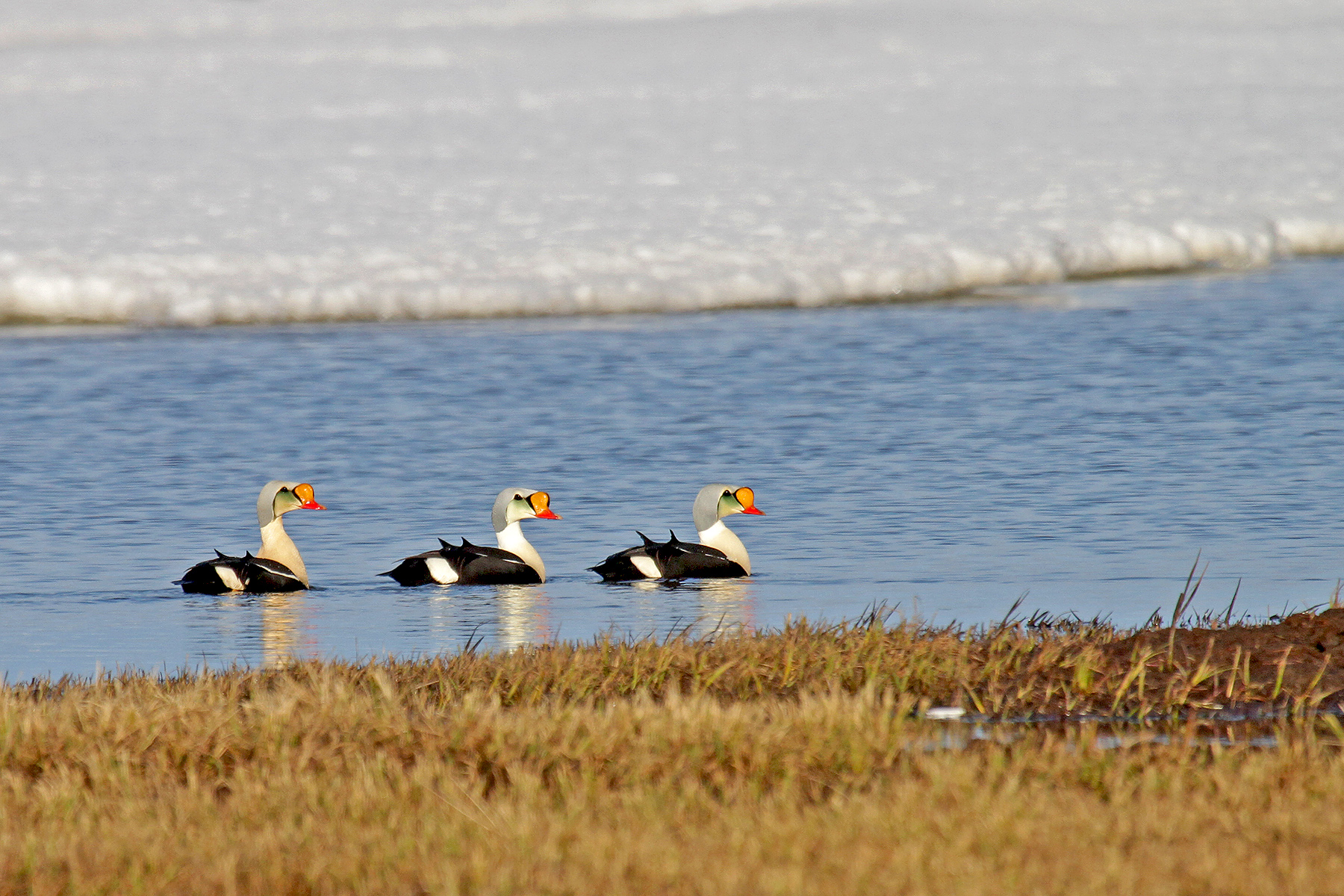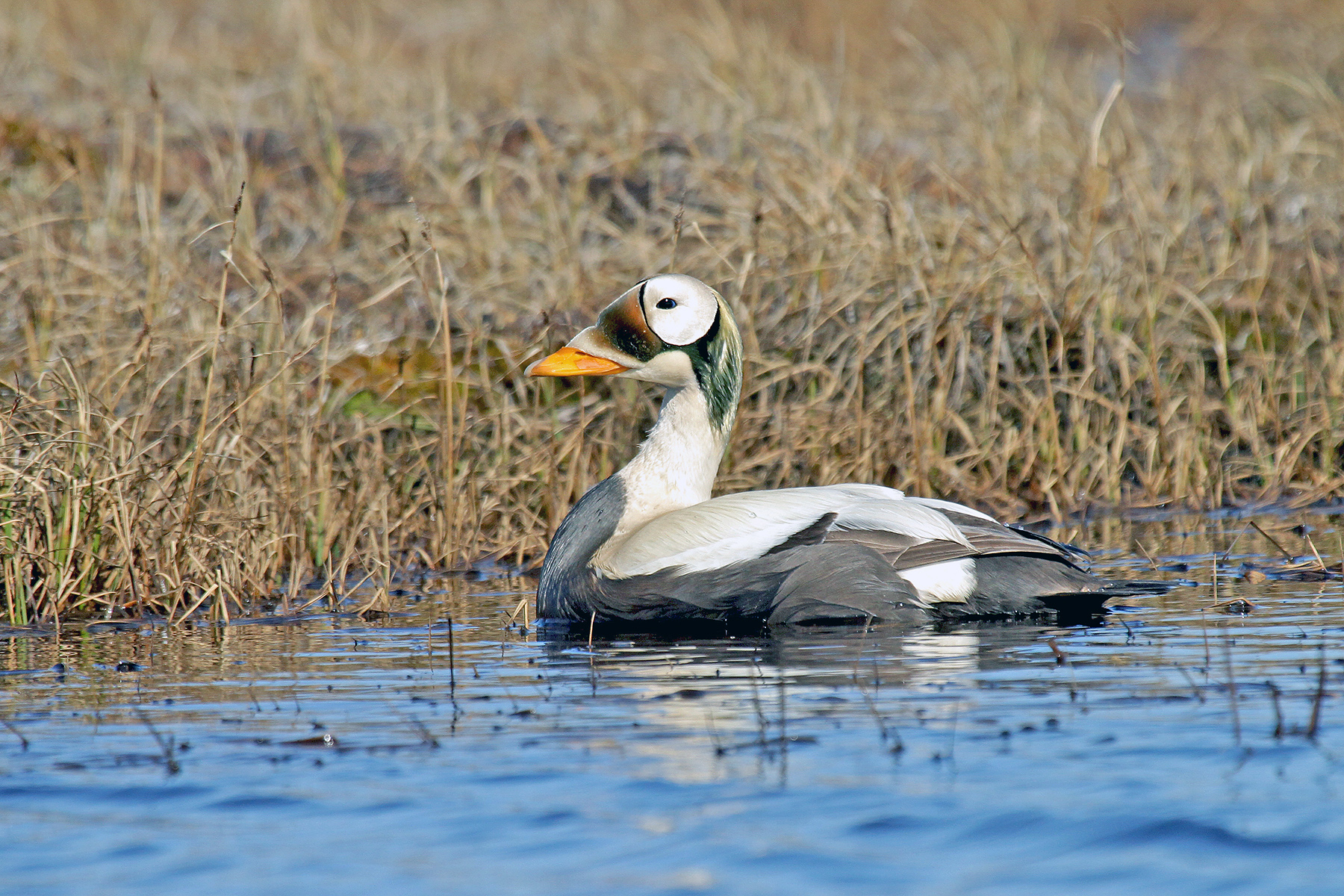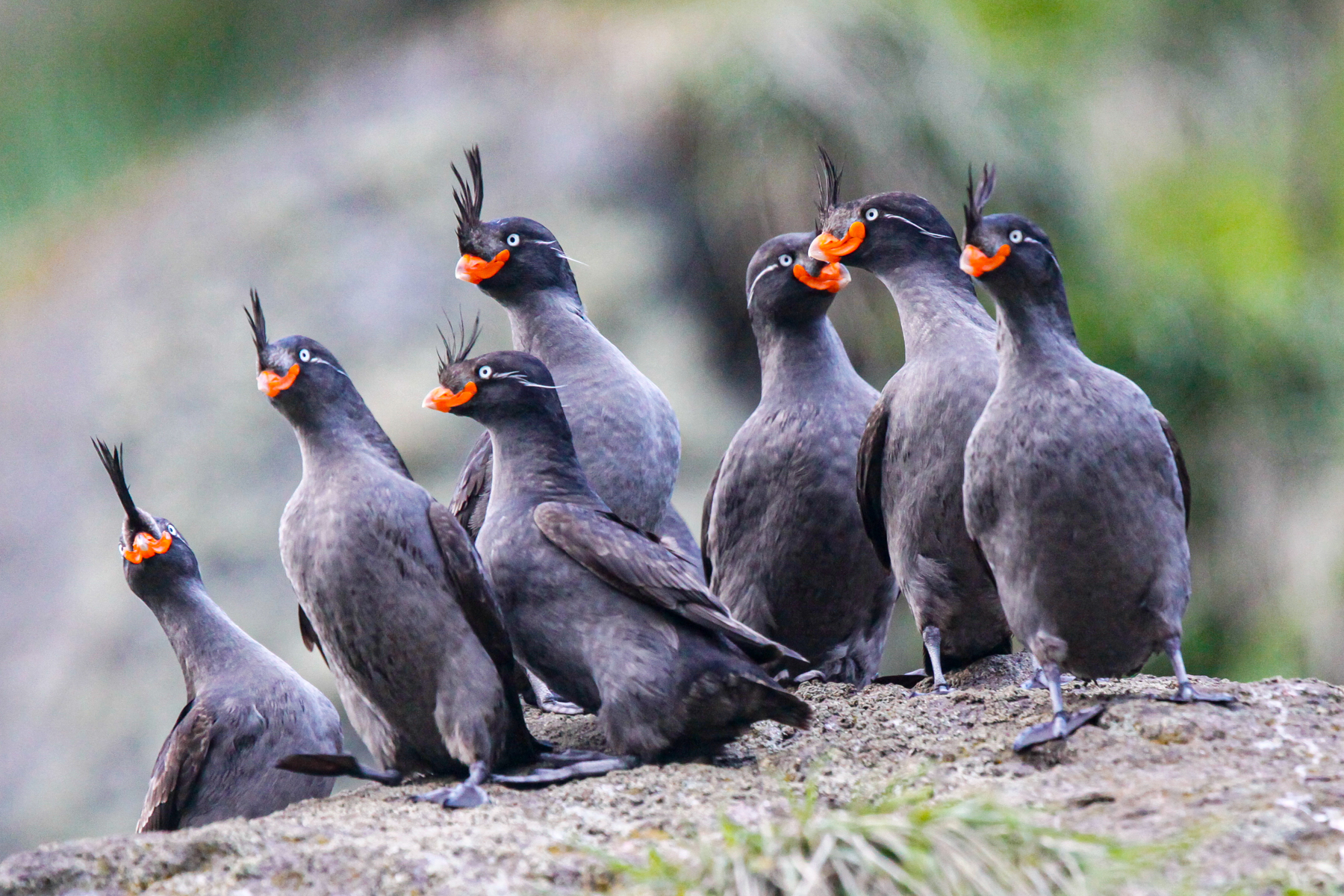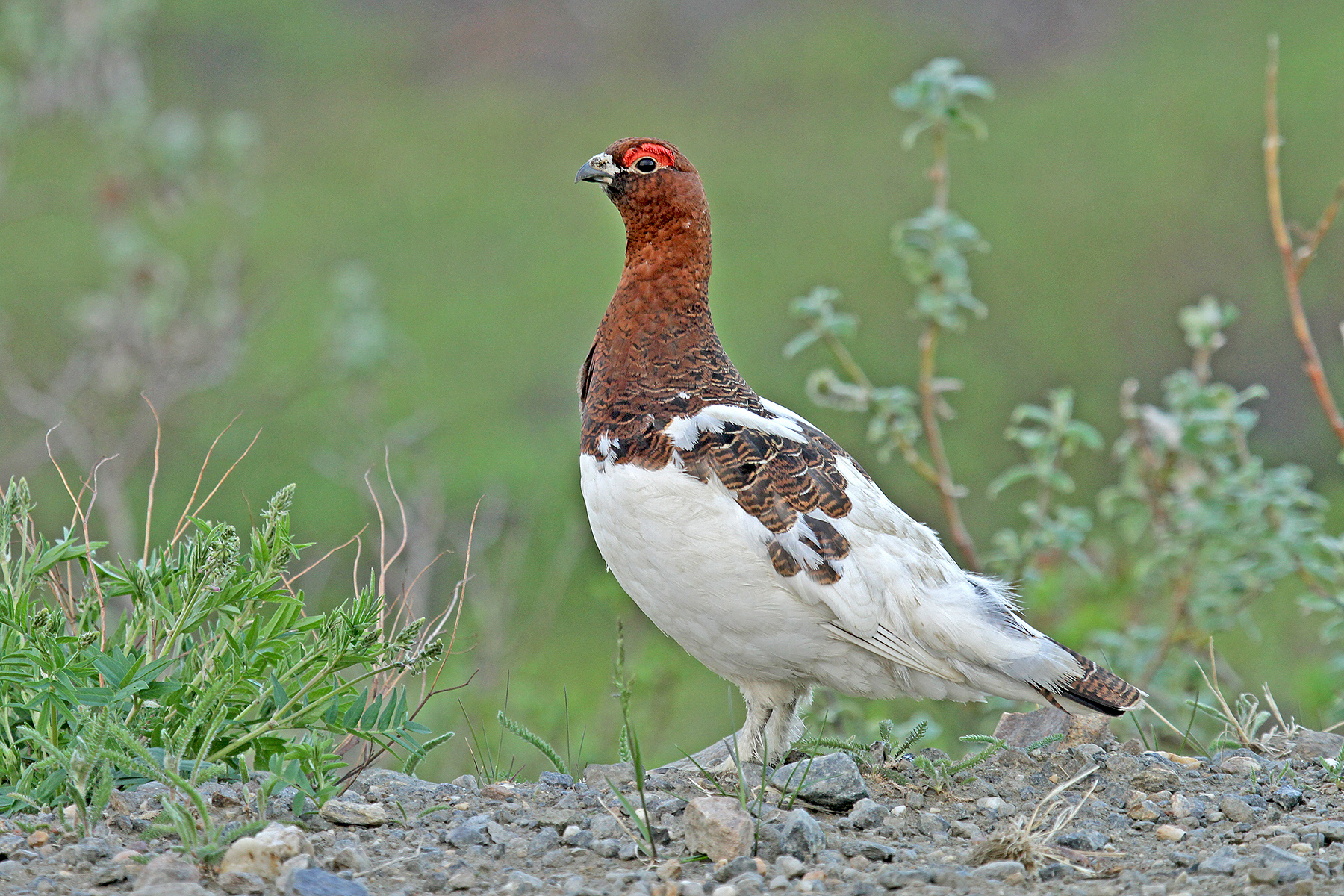ALASKA BIRDING TOUR: DETAILED ITINERARY
Alaska: Day 1 The tour begins this evening in Anchorage, where we will stay overnight.
Alaska: Day 2 Early this morning we will visit Lake Spenard and Lake Hood where we will have our first introduction to Alaskan birding. Here we may well see Pacific Loon (or Pacific Diver), Red-necked Grebe, Lesser Canada Goose, Spotted Sandpiper, Red-necked Phalarope, Mew and Bonaparte’s Gulls, Violet-green and Tree Swallows, and a variety of ducks including Green-winged Teal, American Wigeon, Greater and Lesser Scaups and Barrow’s Goldeneye, whilst the surrounding scrub holds American Robin, Myrtle Warbler, Black-capped Chickadee, Black-billed Magpie, Pine Siskin, Dark-eyed Junco and Savannah, Lincoln’s and White-crowned Sparrows. We will also have our first chance for Rusty Blackbird.
Afterwards, a morning flight will take us to far western Alaska and the town of Nome for a four nights stay. We will have the rest of the day to explore the surrounding area.
Alaska: Days 3-5 Situated on Norton Sound on the Bering Sea coast, Nome is a Mecca for birders in search of arctic specialities. We will use the three roads leading out of the town and explore the varied habitats in search of some of North America’s rarest birds. Bounded by tundra on three sides and the Bering Sea coast on the other, the small estuary and lakes at the edge of town attract many waterbirds including the stately Sandhill Crane, Semipalmated and Pacific Golden Plovers, Western and Semipalmated Sandpipers, Wandering Tattler, Surfbird, Black Turnstone and sometimes Red-necked Stint and Vega and Slaty-backed Gulls (the latter two often amongst the many Glaucous Gulls). We will drive along the coast towards Safety Sound, a real migrant trap, where birds pause whilst the ice further north breaks up. The uncommon Emperor Goose and the dainty Sabine’s Gull turn up regularly here on migration and there is always the chance of a real rarity.
More commonly encountered birds we can expect to find in this fine area include Red-throated Loon (or Red-throated Diver), Tundra Swan, Black Brant, Common Eider, the beautiful Harlequin Duck, Surf Scoter, Black Scoter, White-winged Scoter, Long-tailed Duck, Arctic Tern, the elegant and much-sought-after Aleutian Tern and the smart Lapland Longspur (or Lapland Bunting). Small numbers of Thick-billed Murres (or Brünnich’s Guillemots) can also be found along the coastline.
On one day we will leave early for a drive along the famous Kougarok Highway in search of one of the world’s least-known birds, the Bristle-thighed Curlew, which is currently under study by the United States Fish and Wildlife Service. We will devote part of the day to finding this rare and sometimes difficult species which shares its habitat with the more common and very similar Hudsonian Whimbrel. With persistence we should be treated to views of both, allowing us to make direct comparisons between these two closely related species. During our drive along the Kougarok Highway, we will pass through the scenic Kigluaik Mountains. The many cliffs here provide nesting habitat for a number of raptors including Golden Eagle, Rough-legged Buzzard (or Rough-legged Hawk) and the magnificent Gyr Falcon.
Other breeding birds we will look out for are Peregrine Falcon, Rock and Willow Ptarmigans, American and Pacific Golden Plovers, Long-tailed and Parasitic Jaegers (or Long-tailed and Arctic Skuas), American Cliff Swallow, Grey-cheeked Thrush, Rusty Blackbird, American Tree, Red Fox and Golden-crowned Sparrows, and Arctic (or Hoary) and Common Redpolls. Bar-tailed Godwit is an uncommon possibility. Several primarily Eurasian passerines nest locally in Alaska, including Alaska Wagtail (the local form of the Eastern Yellow Wagtail complex), Bluethroat and Northern Wheatear.
We should also find the extraordinary Musk Ox, which is sometimes present in good numbers, as well as Caribou (or Reindeer) and American Beaver. Sometimes we get sightings of Brown Bear in this exciting area.
Alaska: Day 6 After some final birding in the Nome area we will take an afternoon flight back to Anchorage for an overnight stay.
Alaska: Day 7 Before breakfast we will have an opportunity to visit Westchester Lagoon in the centre of Anchorage where we should see Short-billed Dowitcher and Hudsonian Godwit.
Later we will drive southwards on one of Alaska’s most scenic roads to the little town of Seward for a two nights stay.
Our first stop as we drive south will be at a forest area where we have first chances for Spruce Grouse and American Three-toed Woodpecker, as well as Canada (or Grey) Jay, the strikingly-coloured Varied Thrush, Golden-crowned Kinglet, Boreal Chickadee, Red-breasted Nuthatch, Townsend’s Warbler and Two-barred (or White-winged) Crossbill.
At various wetlands along the route, we can expect to find a number of new species, including the impressive Trumpeter Swan, Ring-necked Duck, Redhead, the impressive Belted Kingfisher, Alder Flycatcher, Wilson’s Warbler and Song Sparrow.
Continuing south, we will stop at Beluga Point and scan the waters on the off chance that some stunning white Beluga Whales have come to hunt for salmon in the bay. Closer to Seward, the surrounding hillsides harbour a healthy population of Thinhorn Sheep and we will pass some spectacular mountain scenery and stop frequently to explore the surrounding forests, lakes and mountain passes for some of the birds typical of this habitat including Common Loon (or Great Northern Diver), Northern Flicker, the tiny Rufous Hummingbird (the world’s most northerly ‘hummer’, here at the edge of its range), Olive-sided Flycatcher, Hermit and Swainson’s Thrushes, the colourful Steller’s Jay, Brown Creeper, Pacific Wren and the restricted-range Northwestern Crow.
Alaska: Day 8 The highlight of our visit to Seward will undoubtedly be a cruise out into the Kenai Fjords, truly one of Alaska’s greatest treasures. High, snow-capped mountains, magnificent glaciers that protrude into the pristine waters like icy fingers and abundant wildlife all make for an enthralling excursion. Glaucous-winged Gulls and Black-legged Kittiwakes are abundant, and as soon as we leave the dock we will start to look for the superb selection of auks that frequent the area and in particular, we will be keeping our eyes peeled for Pigeon Guillemot, Common Murre (or Common Guillemot), Ancient, Marbled and Kittlitz’s Murrelets, Parakeet and Rhinoceros Auklets, and Horned and Tufted Puffins.
Other species we should encounter include Pelagic and Double-crested Cormorants, American Black Oystercatcher and perhaps Short-tailed Shearwater. Marine mammals are also well represented and we will keep a constant lookout for huge Humpback Whales, impressive Killer Whales (or Orcas), fast-moving Dall’s Porpoises and Steller’s Sealions. The superb Sea Otter is often present in large numbers, while Bald Eagles can often be seen resting on the mudflats and cliffs near Seward or lumbering across the bay.
Alaska: Day 9 Today we will explore the extensive spruce forests that clothe the Seward area and the Kenai Peninsula. By walking some easy trails we can expect to see many of the forest specialities of south-western Alaska. Amongst the species that we hope to find are the tame but sometimes elusive Spruce Grouse, the Harlan’s form of the Red-tailed Hawk, American Three-toed Woodpecker, Hairy Woodpecker, the strikingly-coloured Varied Thrush, Ruby-crowned Kinglet, Chestnut-backed Chickadee, the nomadic Bohemian Waxwing (if we are lucky), Pine Grosbeak and Orange-crowned and Blackpoll Warblers. We will also be keeping a constant lookout for Black Bears, which are quite common, though elusive, in this area. Eventually, we will return to Anchorage for an overnight stay.
Alaska: Day 10 Today we will set off early and make our way northwards and eastwards to the Paxson region for an overnight stay.
As we pass the Denali region, given clear weather, we should have breathtaking views of the huge massif of Mount McKinley (or Mount Denali), which, at an impressive 6195m, is the highest peak in North America.
We will also be on the lookout for Northern Harrier, Merlin, Say’s Phoebe, Buff-bellied (or American) Pipit, Northern Shrike and White-winged (or Two-barred) Crossbill.
Working our way east, we will check some of the many ponds and small lakes for a number of species, including Horned (or Slavonian) Grebe, Bufflehead, Least Sandpiper and Greater and Lesser Yellowlegs. Here, we will witness a landscape literally littered with beaver lodges! Moose are also quite plentiful along this stretch of road and many of them have young (mostly twins) at this time of year.
This is prime duck-breeding territory, and although we will have seen most of the species already, the scenic beauty along the highway and the abundance of birdlife on the pools will once again have us awestruck!
The scrub and forest along the highway hold Yellow Warbler and Northern Waterthrush, as well as Arctic Warbler, the only Phylloscopus warbler to nest in North America. This area is also one of the best in Alaska to search for Northern Hawk Owl. These superb diurnal predators are typically spotted perched on the top of a spruce tree.
Alaska: Day 11 This morning, we will make a concerted effort to find one of Alaska’s more elusive inhabitants, the delightful Smith’s Longspur. This striking bunting arrives exceptionally late on its breeding grounds and is right at the edge of its range in this area. It also seems to be getting rarer, but nevertheless, we shall diligently search suitable damp grassy areas in the hope of finding one. Later in the day, we will head back to Anchorage for an overnight stay, passing some of the most amazing glaciers one could ever hope to see!
Alaska: Day 12 This morning we will fly northwards, crossing the Arctic Circle, the impressive Brooks Range and the vast tundras of Alaska’s North Slope en route to the small town of Utqiagvik (formerly Barrow) for a two nights stay beside the Arctic Ocean. If the weather is clear we should enjoy some fantastic views as we fly over vast areas of unspoilt wilderness.
As we approach Utqiagvik we will pass over a flat tundra landscape dominated by a honeycomb pattern of huge ice-wedge polygons that have been formed by the endless annual cycle of the thawing and freezing of the permafrost. Here at more than 71°N latitude, the sun does not set for nearly three months in summer (although the frequent arctic fog may make us forget that this is the ‘Land of the Midnight Sun’!), while in the icy depths of winter it stays below the horizon for just as long.
Our programme will to a certain degree be determined by the extent of the sea ice, which is likely to be only just starting to break up in mid-June. If conditions are favourable we may spend some time this afternoon scanning open water areas amongst the ice for divers and ducks, and, of course, there is always that slim possibility of a Polar Bear to keep the adrenalin flowing!
Alaska: Day 13 Today we will explore various places in the Utqiuagvik (Barrow) area, taking advantage of the continuous daylight at this time of the year! The tundra here is particularly rich in breeding wildfowl and shorebirds and by now the surface ice will have begun to melt, forming pools that lie on top of the permafrost. At this season the tundra is alive with the sights and sounds of displaying ducks and waders whilst menacing skuas patrol back and forth.
Our main quarry here will be the gorgeous, though sadly declining, Spectacled Eider and we should be able to locate one or more pairs on the tundra pools. We will also be keenly scanning the tundra for the beautiful Steller’s Eider and that truly arctic predator, the Snowy Owl. The populations of many arctic predators fluctuate enormously in parallel with the cyclic changes in the lemming and vole populations. These small rodents, known for their boom and bust cycles which take place once every four to five years, are the main food source for many of the birds and mammals here in the far north.
Amongst the other interesting species that we can expect to find during our forays are the uncommon Yellow-billed Loon (or Yellow-billed Diver), Greater White-fronted Goose, the handsome King Eider, Baird’s and Pectoral Sandpipers, Long-billed Dowitcher, Red (or Grey) Phalarope (here in its splendid red breeding plumage and hopefully displaying), Pomarine Jaeger (or Pomarine Skua) and Black Guillemot. We also have another chance of seeing Sabine’s Gull, although this species is sometimes absent until later in the summer.
A number of shorebird species are breeding at the extreme limit of their range in this area and therefore occur in fluctuating numbers from one year to the next (and so are of unpredictable occurrence). These include Grey (or Black-bellied) Plover, Sanderling, White-rumped Sandpiper, the dainty Buff-breasted Sandpiper and Ruddy Turnstone.
Alaska: Day 14 After a final morning at Utqiagvik (Barrow) we take a flight back to Anchorage for an overnight stay.
Alaska: Day 15 Our Alaska birding tour ends this morning at Anchorage.
ST PAUL (PRIBILOF ISLANDS) EXTENSION
Alaska (Pribilofs): Day 1 The extension begins this evening in Anchorage, where we will stay overnight.
Alaska (Pribilofs): Day 2 Today we will take a flight to St Paul Island, situated some 800 miles (1300 km) from Anchorage in the Pribilofs, where the largest remaining Aleut community in the world resides. Typically the flight takes off in the morning, arriving in the afternoon. Situated amidst the cold waters of the Bering Sea, these islands are home to some three million seabirds! Upon our arrival, we will be transferred to the King Eider Hotel, our base for the next three nights. Later we will set out by bus to begin our explorations of the island.
Alaska (Pribilofs): Days 3-4 The Pribilofs offer a seabird spectacle that has made them world-famous amongst birders. During our stay, we will have time to visit some of the best seabird breeding areas on St Paul.
At Reef Point, not far from the settlement, the cliffs hold many seabirds. Northern Fulmars, Black-legged Kittiwakes, puffins, auklets, guillemots and cormorants seem to occupy every available piece of rock and by carefully searching the cliffs we should gain fantastic views of all of the nesting alcids (auks). Common and Thick-billed Murres (or Common and Brünnich’s Guillemots) and diminutive Least Auklets are abundant, whilst bizarre Crested Auklets and Parakeet Auklets are much in evidence and comical Horned and Tufted Puffins are constantly travelling to and from their breeding ledges. A few Pigeon Guillemots breed below the cliffs.
Other highlights here will include Red-faced Cormorant and the extremely localized Red-legged Kittiwake (which only breeds here and on a few other islands in the Aleutian and Komandor islands). Arctic Foxes, here of the Pribilof subspecies which remains largely dark even during the winter, will be keeping a close eye on us as they den close to the bird cliffs.
We will also have the opportunity to visit a Northern Fur Seal colony where we will be able to admire some large bulls at close range from behind one of the specially erected hides (blinds), their incredible barking calls ringing through the air.
Around the edge of the little town, we can expect to find Gray-crowned Rosy Finch (here of the distinctive Pribilof race umbrina), the handsome Lapland Longspur (or Lapland Bunting) and the Pribilof form of the Pacific Wren. Salt Lagoon and the freshwater lakes and marshes are likely to produce various wildfowl, shorebirds and gulls, including Long-tailed Duck, Semipalmated Plover, Least Sandpiper, large numbers of Glaucous-winged Gulls and sometimes lingering Glaucous Gulls.
St Paul is famous among North American birders for its vagrants from Siberia that occur here, but it is important to understand that the most likely scenario is that you will see just a few such species during a visit. Strays (and Eurasian species that even breed here) that we have recorded include Eurasian Wigeon, Eurasian Teal, Tufted Duck, Eurasian Hobby, Lesser Sand Plover, Long-toed Stint, Common Snipe, Wood and Common Sandpipers, Common Greenshank, Grey-tailed Tattler, Slaty-backed Gull, Common and Oriental Cuckoos, Olive-backed Pipit, Siberian Rubythroat, Eyebrowed Thrush and Brambling.
In the southwestern part of the island, we will visit more seabird cliffs where beautiful Harlequin Ducks are commonly seen offshore and Buffleheads are often present. Providing weather conditions are good (fog can be a problem here) we can expect to enjoy close up views of many of the auk species.
Another of the speciality birds on St Paul is the Pribilof race of the restricted-range Rock Sandpiper, which nests on the dry tundra.
The beautiful McKay’s Bunting, a species (or perhaps just a race of Snow Bunting) restricted to a few islands in the Bering Sea, sometimes winters on St Paul and very occasionally lingers until late May. In the last decade or so there have been very few May records, so we will count ourselves exceedingly fortunate if we come across one.
Alaska (Pribilofs): Day 5 After some final birding on St Paul we will take a flight back to Anchorage for an overnight stay.
[Note: We will actually be staying in Anchorage for two nights, but the second night is part of the main tour. The reason we need a ‘safety day’ in Anchorage in between St Paul and the main tour is that fog or high winds are issues in the Bering Sea and a flight delay to the return leg is a possibility that must be catered for.]
Alaska (Pribilofs): Day 6 Today we will explore the region north of Anchorage. We are going to see plenty of species that will feature on the main tour, but we will be concentrating on two that will not: the lovely White-tailed Ptarmigan (backcountry road conditions permitting!) and the uncommon Black-backed Woodpecker.
This evening we will meet up with those arriving for the main tour.
DUTCH HARBOR (ALEUTIAN ISLANDS) EXTENSION
Alaska (Dutch Harbor): Day 1 The extension begins this evening in Anchorage, where we will stay overnight.
Alaska (Dutch Harbor): Day 2 This morning we will take a flight to the remote but bustling fishing port of Dutch Harbor on Unalaska Island in the Aleutian Chain.
We will be staying in Dutch Harbor for three nights and we will have the rest of the day to explore the island.
Alaska (Dutch Harbor): Days 3-4 Unalaska Island is an interesting place, and not just for pelagic boat trips in search of wonderful seabirds.
Rock Sandpipers nest on the island and other species we are likely to find include Harlequin Duck, Rock Ptarmigan, Black Oystercatcher, Least Sandpiper, Pacific Wren, Buff-bellied (or American) Pipit, Lapland Longspur (or Lapland Bunting), Savannah Sparrow, ‘Sooty’ Fox Sparrow and the large, distinctive Aleutian race of the Grey-crowned Rosy Finch. Bald Eagles are positively common on Unalaska.
The main highlight of our visit to Dutch Harbour will undoubtedly be our pelagic boat trip out to the Chelan Banks and the Baby Islands. We will spend 8-10 hours at sea altogether on our large and comfortable charter boat band will have plenty of time to enjoy the seabird spectacle.
We should see tens or more likely hundreds of Whiskered Auklets in total and will probably enjoy good views of these zany alcids on the water or flying past our boat. Another highlight is Cassin’s Auklet, but numbers of those will likely be small or into the tens. A number of Laysan Albatrosses will be seen and by ‘chumming’ we should attract some in for close views. If we are in luck we will see a Black-footed Albatross or even a Short-tailed Albatross! While the restricted-range Red-legged Kittiwake is not certain here, we have a very good chance of seeing one or more.
As well as these major specialities, we can also expect to see Pelagic, Double-crested and Red-faced Cormorants, lots of Northern Fulmars (almost all of the dark Pacific morph), Black-legged Kittiwakes and Glaucous-winged Gulls, hordes of comical Tufted Puffins and good numbers of Common Murres (or Common Guillemots), Pigeon Guillemots, Horned Puffins and Ancient Murrelets and small numbers of Marbled Murrelets and Crested and Parakeet Auklets. Often Short-tailed Shearwaters are present (and they can be numerous), as are a few Thick-billed Murres (or Brünnich’s Guillemots), while rarities include Fork-tailed Storm Petrel and Mottled Petrel.
We may see Kittlitz’s Murrelet during the pelagic, but quite often they can be seen well from the shore, especially late in the day.
Alaska (Dutch Harbor): Day 5 After some final birding on Unalaska Island we will fly back to Anchorage where we will overnight.
[Note: We will actually be staying in Anchorage for two nights, but the second night is part of the Saint Paul (Pribilofs) extension. The reason we need a ‘safety day’ in Anchorage in between Dutch Harbor and the St Paul extension is that fog or high winds are issues in the Aleutian Islands and a flight delay to the return leg is a possibility that must be catered for.]
Alaska (Dutch Harbor): Day 6 We will enjoy some local birding around Anchorage today before we join up with those arriving for the Pribilofs extension this evening.

















